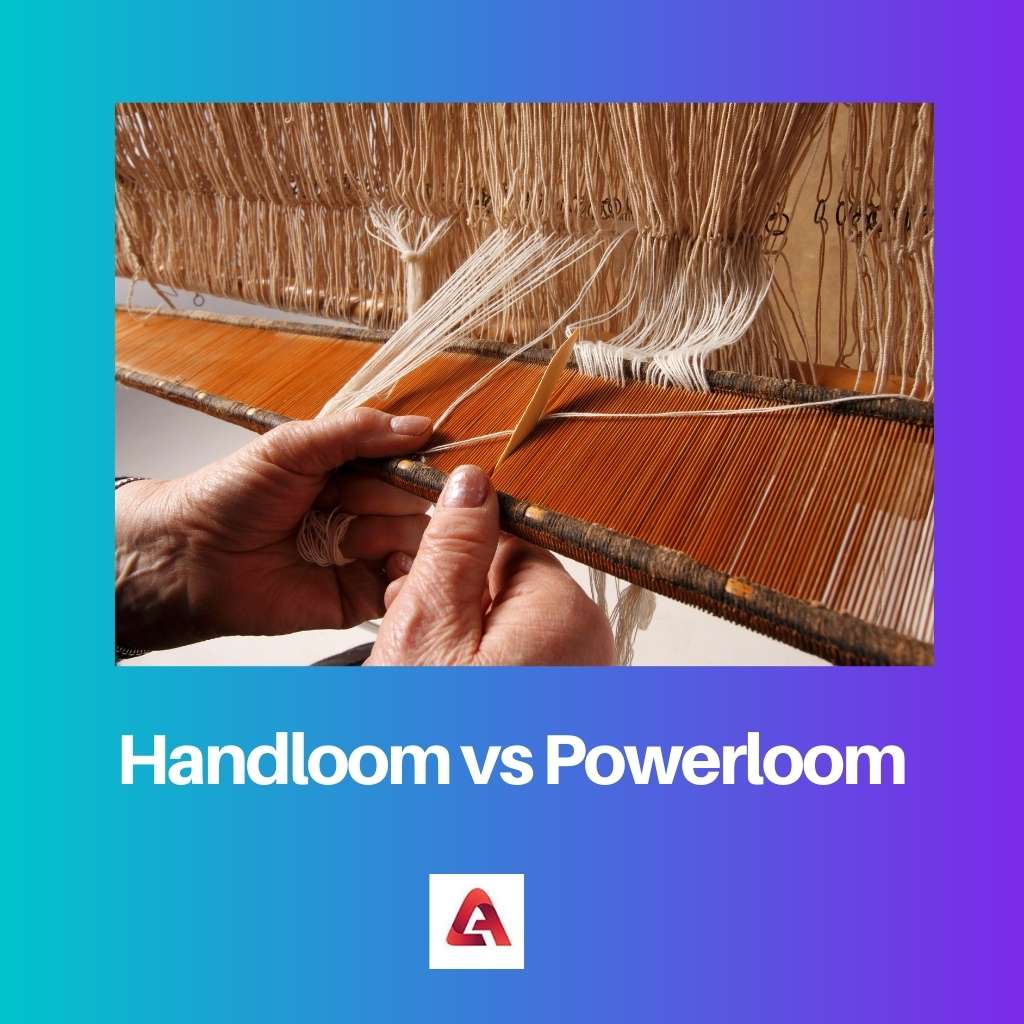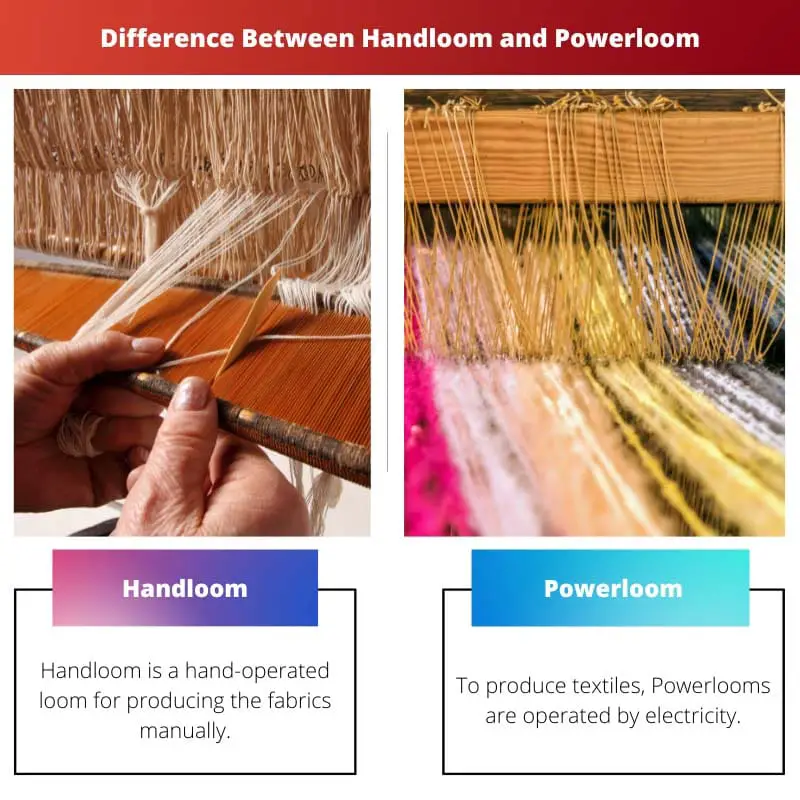The textile industry is one of the largest industries in the world, with looms set up for tapestry and thread weaving (from which the fabrics are made). Loom has been used for ages and has its origin in the English language.
Handloom and Powerloom are two types of looms for weaving clothes. These technologies have been used worldwide from the ages.
Key Takeaways
- Handloom weaving is a traditional, manual process that relies on human skill, while powerloom weaving uses mechanized equipment for faster production.
- Handloom products exhibit unique, intricate designs and higher quality, whereas powerloom products tend to have uniform patterns and may need different craftsmanship.
- Handloom weaving supports local artisans and promotes sustainability, while powerloom weaving contributes to mass production and industrialization.
Handloom vs Powerloom
Handlooms are manually operated looms used for weaving where picking and beating are done by human hands. Handloom fabric is soft in texture. Powerlooms are mechanized looms driven by rod motors or electrical power by the fabric industry to weave patterns or thread into cloth.

Hoomloom is a device made from wood that is for weaving threads manually. Weavers use this tool to create beautiful, aesthetic, and well-designed handcraft fabrics that appeal to buyers. In India, handloom started in the year 1905 in August.
Moreover, 7th August has been celebrated as the national handloom day in India.
Powerloom is a mechanical way for weaving different fabrics, and this technique was the revolution in the textile industry. It requires less labor than handloom to operate and design, and it weaves the thread quickly with the connection of electricity.
The first Powerloom was built in the 18th century in England by Edmund Cartwright.
Comparison Table
| Parameters of Comparison | Handloom | Powerloom |
|---|---|---|
| Production | Handloom is a hand-operated loom for producing the fabrics manually. | To produce textiles, Powerlooms are operated by electricity. |
| Efficient | Handloom runs at a slow speed so, it is less efficient. | Powerloom finishes the work quickly having, high efficiency. |
| Flexibility | Due to its manual nature, a designer can incorporate fewer patterns. | Powerloom allows the artist to make multiple complex designs. |
| Investment | The investment is less for the designing sector and higher for paying wages to the creative artist. | The investment is higher in the designing sector due to electricity, and it is lower for paying wages. |
| Design | Design can include complex and polychrome tones. | The design consists of monochrome tones. |
What is Handloom?
Handloom is wooden weaving equipment built during the Indus Valley civilization.
People used to sew their clothes with a needle and stencils, which was difficult, time-consuming, and harmful to their health. Therefore, the invention of handloom in that era was a boon for people.
The handloom allows artisans to better display their expertise in weaving unique materials. It indicates that artisans employed handloom to turn natural textiles (cotton, jute, wool) into clothing.
Since it is a manual machine, artists can weave threads into multiple patterns and designs. Moreover, artists can complex the design as per their skills and visualization.
Handloom had a significant role in the history of an Asian country, India, during the Swadeshi Movement during the British era.
At that time, Indians boycotted international textiles and designed their clothes (dhotis, sarees, towels, handkerchiefs) with handlooms.
Moreover, the National handloom is also celebrated in India every year on 7th August to honor the talented weavers for designing clothes. It is an ecofriendly way for producing clothes.
The investment in machinery was minimal, the need for manufacturing labor was significant.
However, due to the rising demand for textiles, it has proven to be an inadequate method for producing more quantities of designs in a short amount of time.

What is Powerloom?
Powerloom, as the name suggests, it means that weaving is carried out with the help of power instead of designing the clothes manually. It was created in the eighteenth century.
Though a few expertise brought alterations under its look and functioning, it is patent under the name of an English man Edmund Cartwright (the original creator of Powerloom).
It brought further evolution in the textile industry when an artist could design clothes with machines in less time. Moreover, it is beneficial for the textile factories because they have to hire less labor for delivering high output.
Moreover, with Powerloom, industries can provide more designer fabrics to the fashionistas by incorporating multiple patterns. The initial investment in Powerloom is high because one has to purchase it and connect it with electricity.
Later, it helps in making great money when installed. Moreover, lower warp sheds (alignment of threads or wool in the loom) are required while weaving. Most of the textile industry depends on Powerloom for manufacturing fabrics.
There are a few disadvantages of Powerloom. The first is that labor can weave single hue clothes instead of embedding multiple color threads, unlike handloom.
Another issue is clothes woven by Powerloom are tight so, clothing can be uncomfortable to wear.

Main Differences Between Handloom and Powerloom
- The handloom machine first appeared during the Indus Valley Civilization. On the other hand, Powerloom developed after the invention of electricity in the late 18th century.
- The handloom operates manually. However, Powerloom runs by power.
- The handloom makes more comfortable and breathable fabrics when compared with Powerloom.
- The handloom equipment is less efficient and more time-consuming than the Powerloom.
- The handloom machine can make fewer patterns than the Powerloom.
- The handloom requires a higher warp shed. However, Powerloom requires a lower warp shed.
- An initial investment in the handloom machine is less when compared to the Powerloom, which requires a high investment at the initial stage.

- https://www.jstor.org/stable/4401712
- https://www.researchgate.net/profile/Rajkishore-Nayak-3/publication/289352707_Study_of_handle_and_comfort_properties_of_poly-_Khadi_handloom_and_powerloom_fabrics/links/56d639b808aee73df6c05b20/Study-of-handle-and-comfort-properties-of-poly-Khadi-handloom-and-powerloom-fabrics.pdf
